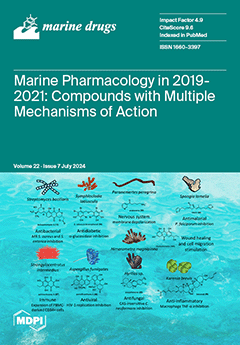A bioassay-guided chemical investigation of a bacterium,
Streptomyces sp. CMB-MRB032, isolated from sheep feces collected near Bathurst, Victoria, Australia, yielded the known polyketide antimycins A4a (
1) and A2a (
2) as potent inhibitors of
Dirofilaria immitis (heartworm) microfilaria (mf) motility
[...] Read more.
A bioassay-guided chemical investigation of a bacterium,
Streptomyces sp. CMB-MRB032, isolated from sheep feces collected near Bathurst, Victoria, Australia, yielded the known polyketide antimycins A4a (
1) and A2a (
2) as potent inhibitors of
Dirofilaria immitis (heartworm) microfilaria (mf) motility (EC
50 0.0013–0.0021 µg/mL), along with the octapeptide surugamide A (
3) and the new
N-methylated analog surugamide K (
4). With biological data suggesting surugamides may also exhibit activity against
D. immitis, a GNPS molecular network analysis of a library of microbes sourced from geographically diverse Australian ecosystems identified a further five taxonomically and chemically distinct surugamide producers. Scaled-up cultivation of one such producer,
Streptomyces sp. CMB-M0112 isolated from a marine sediment collected at Shorncliff, Qld, Australia, yielded
3 along with the new acyl-surugamides A1–A4 (
5–
8). Solid-phase peptide synthesis provided additional synthetic analogs, surugamides S1–S3 (
9–
11), while derivatization of
3 returned the semi-synthetic surugamide S4 (
12) and acyl-surugamides AS1–AS3 (
13–
15). The natural acyl-surugamide A3 (
7) and semi-synthetic acyl-surugamide AS3 (
15) were shown to selectively inhibit
D. immitis mf motility (EC
50 3.3–3.4 µg/mL), however, unlike antimycins
1 and
2, were inactive against the gastrointestinal nematode
Haemonchus contortus L1–L3 larvae (EC
50 > 25 µg/mL) and were not cytotoxic to mammalian cells (human colorectal carcinoma SW620, IC
50 > 30 µg/mL). A structure–activity relationship (SAR) study on the surugamides
3–
15 revealed that selective acylation of the Lys
3-ε-NH
2 correlates with anthelmintic activity.
Full article






